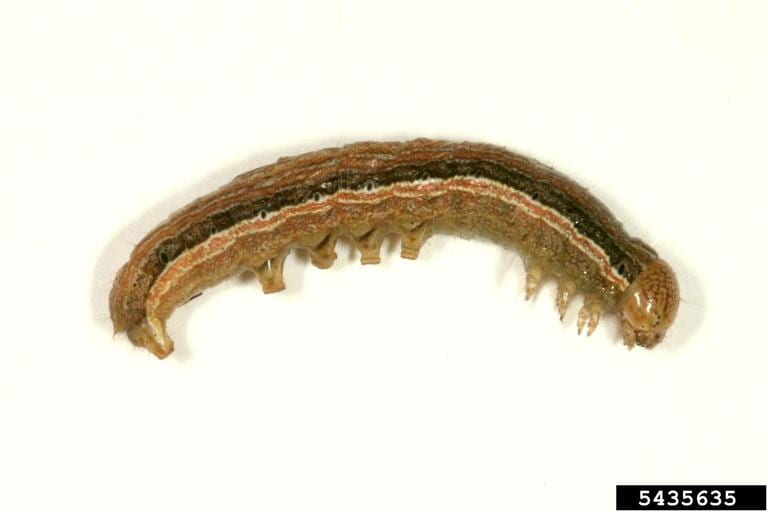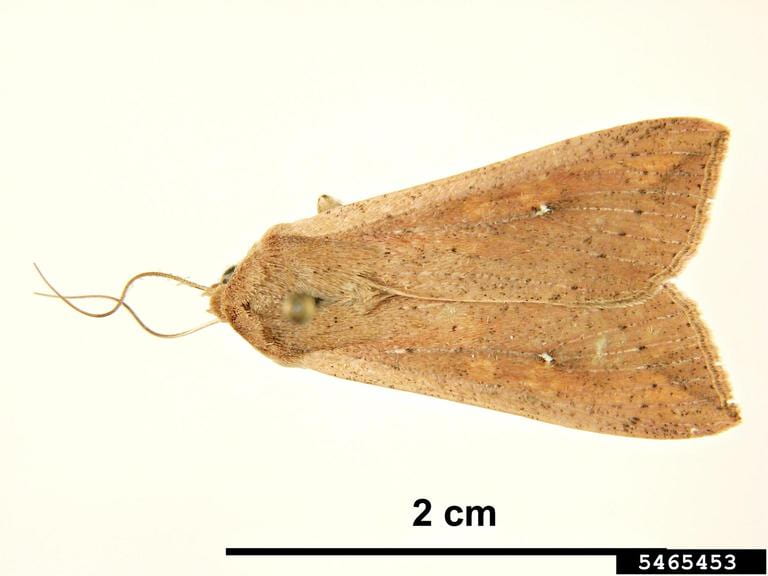We have detected an extremely large population of armyworm moths in Columbus during the past week. This pest prefers to feed on grasses, including corn, wheat, rye, and grassy weeds, but if those plants are in shortage and if populations of armyworm are large, it can infest other crops including alfalfa, beans, cabbage, cucumbers, lettuces, onions, peppers, and radishes. Infestation can be worse in no-till fields than in tilled fields. Any early-planted fields of these crops should be scouted for presence of armyworm. Scouting is best done near dawn or dusk because armyworm larvae are nocturnal and hide in the soil during the day. The name armyworm is given because of the ability of older larvae to form large aggregations that move together from field to field. Infestations can appear quite suddenly in a field, and much damage can occur in a short period of time.
The proper common name of this pest is just ‘armyworm’ but it is often called the true armyworm or the common armyworm, to differentiate it from other species such as fall armyworm, beet armyworm, and yellow-striped armyworm. Its scientific name is Mythimna unipuncta, formerly Pseudaletia unipuncta. It is a member of Order Lepidoptera, Family Noctuidae.
Armyworm larvae are striped, as shown below in Figures 1 and 2. The body is greyish-green or greyish brown with broad dark stripes down its back and along each side, and with a light stripe below the dark stripe on each side. The head is yellow or yellow-brown, marked with net-like brown lines. The body is about 35 mm (1.4 inches) long when fully grown. The larval period lasts about 3 weeks. There are about 2 or 3 generations per year in Ohio. The adult is light brown with a white dot near the center of each forewing, as shown below in Figure 3.
The adult is a moth that can be detected in blacklight traps and pheromone traps. We have had a blacklight trap operating in Columbus since the first week of April. We detected quite a few armyworm moths (0-32 moths per night) throughout April, but there was a large surge on 5/14 when there were 210 armyworm moths in the trap after a single night. Dr Dave Shetlar has been tracking various species of moths in blacklight traps at several locations for several decades, and he thinks that 210 armyworm moths in one night is a new record high number.
The link to our pheromone trap reports is here: https://docs.google.com/spreadsheets/d/10gh3rHahdxLKkXQapGyEPxWsjHYRmgsezOoFHnwtyEo/edit#gid=1122468773
The link to our blacklight trap reports is here: https://docs.google.com/spreadsheets/d/10gh3rHahdxLKkXQapGyEPxWsjHYRmgsezOoFHnwtyEo/edit#gid=1114468121
Sweet corn and field corn that is transgenic due to presence of B.t. should have protection from armyworm feeding. Seed treatments on corn by clothianidin, thiamethoxam, or imidacloprid can offer some suppression from caterpillars such as armyworm, but they are primarily for control of beetles. For sweet corn that is not transgenic, insecticide treatment is suggested if more than 35% of plants show infestation by armyworm during the seedling or early-whorl stages. Insecticides that can be used for armyworm control on sweet corn are pyrethroids (Asana, Baythroid, Brigade, Mustang, Permethrin, Proaxis, Warrior), or Blackhawk, Coragen, Intrepid, Lannate, Lorsban, Radiant, or B.t. products such as Dipel and Javelin.
-by Celeste Welty, Extension Entomologist, 16 May 2020


